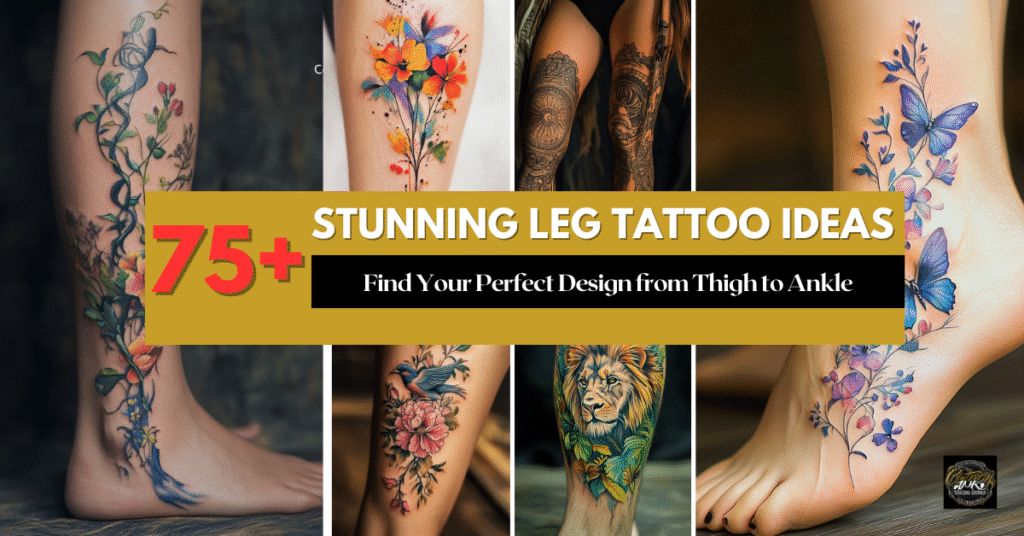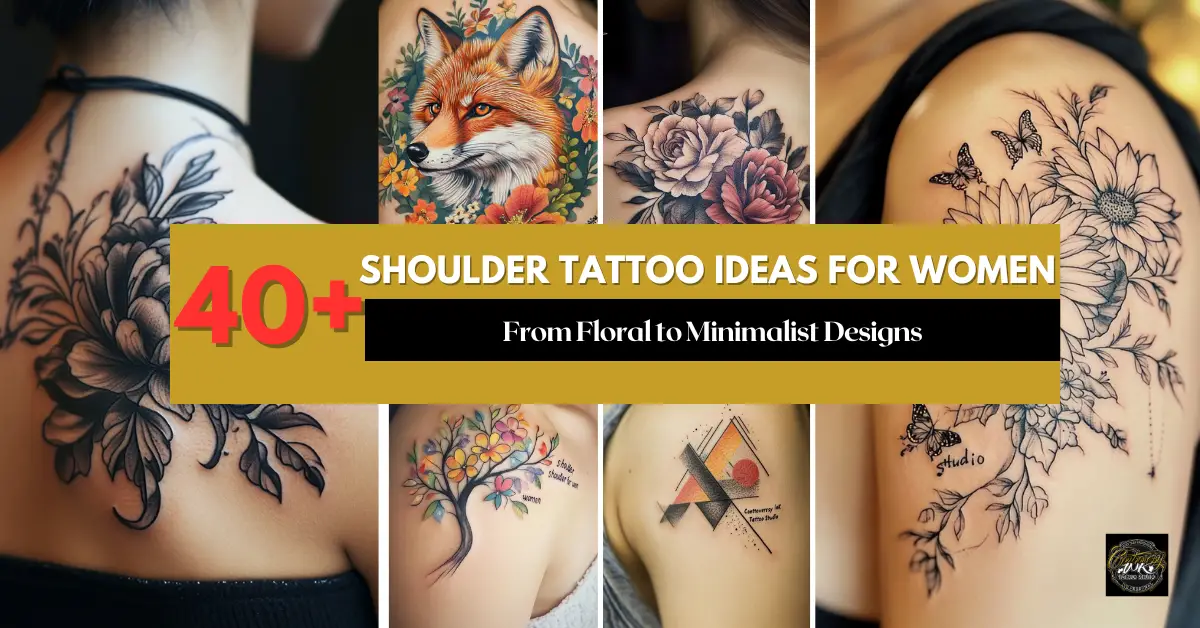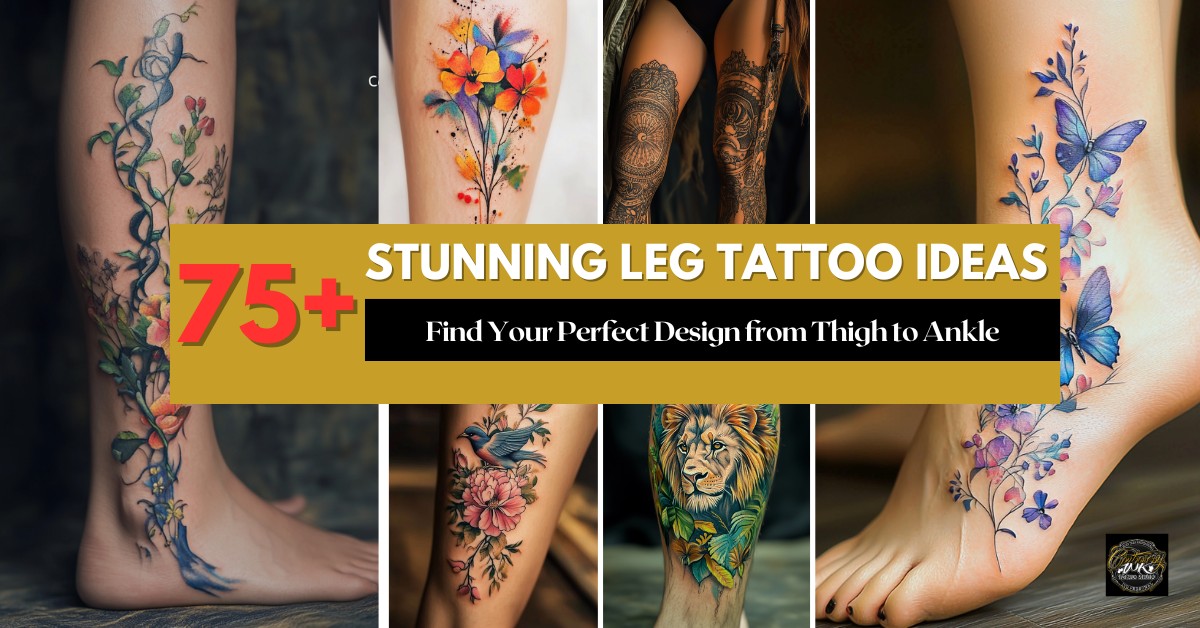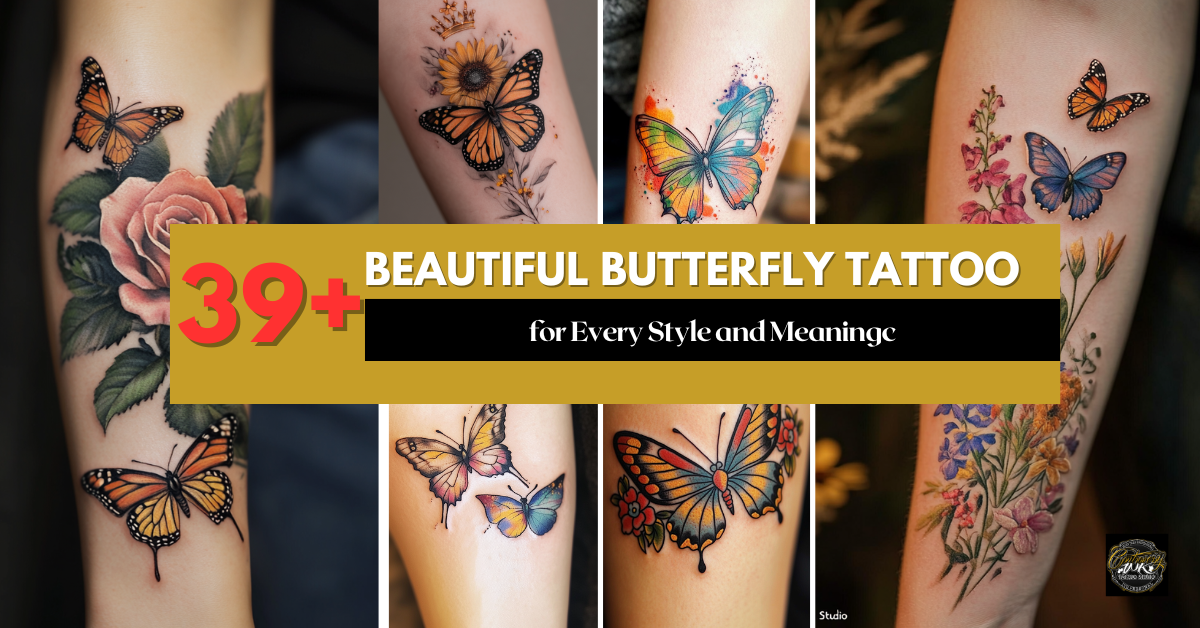If you buy through links on our site, we may earn a small affiliate commission to help support the blog - at no extra cost to you. It never influences our product selection process. Thank you!
Thinking about adorning your legs with some ink? You’re not alone! Leg tattoos have become increasingly popular, offering a perfect canvas for both subtle expressions and bold artistic statements. From delicate florals wrapping around your calf to intricate tribal patterns with modern geometric twists, the possibilities are virtually endless.
Whether you’re drawn to vibrant watercolor splashes, minimalist line work, or dramatic full-leg sleeves telling a story, your leg tattoo can be as unique as you are. Many people are embracing nature-inspired designs, fine-line work, and abstract concepts that transform the leg into a personal gallery. The flat surface of calves and thighs provides an ideal space to develop themes that reflect your personality and passions.
Understanding Leg Tattoo Placements
The leg offers diverse canvases for tattoo art, each with unique advantages for showcasing your design. Choosing the right placement is crucial as it affects visibility, pain level, and how your tattoo interacts with your body’s natural contours.
Upper Leg and Thigh Options

Your thigh provides one of the largest and most versatile surfaces for leg tattoos. Thigh tattoos offer discretion, as you can easily cover them with shorts or pants when needed. This placement is ideal for larger, more detailed designs like portraits, landscape scenes, or elaborate geometric patterns. The upper leg also experiences less friction from clothing than lower placements, which helps maintain the tattoo’s quality over time.
The front thigh works well for designs meant to be viewed straight-on, while the outer thigh creates a natural canvas for pieces that flow with your body’s curves. For something more intimate, the inner thigh can accommodate beautiful, personal designs that you choose to reveal selectively. A study found that approximately 40% of millennials have at least one tattoo, with the upper leg being a popular choice for those seeking a balance between visibility and privacy.
Calf and Lower Leg Possibilities

Lower leg tattoos make a bold statement, especially for those who frequently wear shorts or skirts. The calf muscle offers a prominent, slightly curved surface perfect for vertical designs or pieces that wrap around the leg. With 23% of tattooed individuals choosing the lower leg for their ink, this placement has become increasingly popular, particularly among athletes who want to showcase their body art.
The shin area complements calf designs beautifully, creating opportunities for cohesive full-lower-leg concepts. This flat surface works wonderfully for symmetrical designs like mandalas, tribal patterns, or text. Keep in mind that shin tattoos can be more painful due to the proximity to bone, but they’re highly visible and create striking visual impact. For those not ready to commit to a full leg sleeve, a half-leg design concentrated on the lower portion offers an excellent compromise.
Side Leg Designs
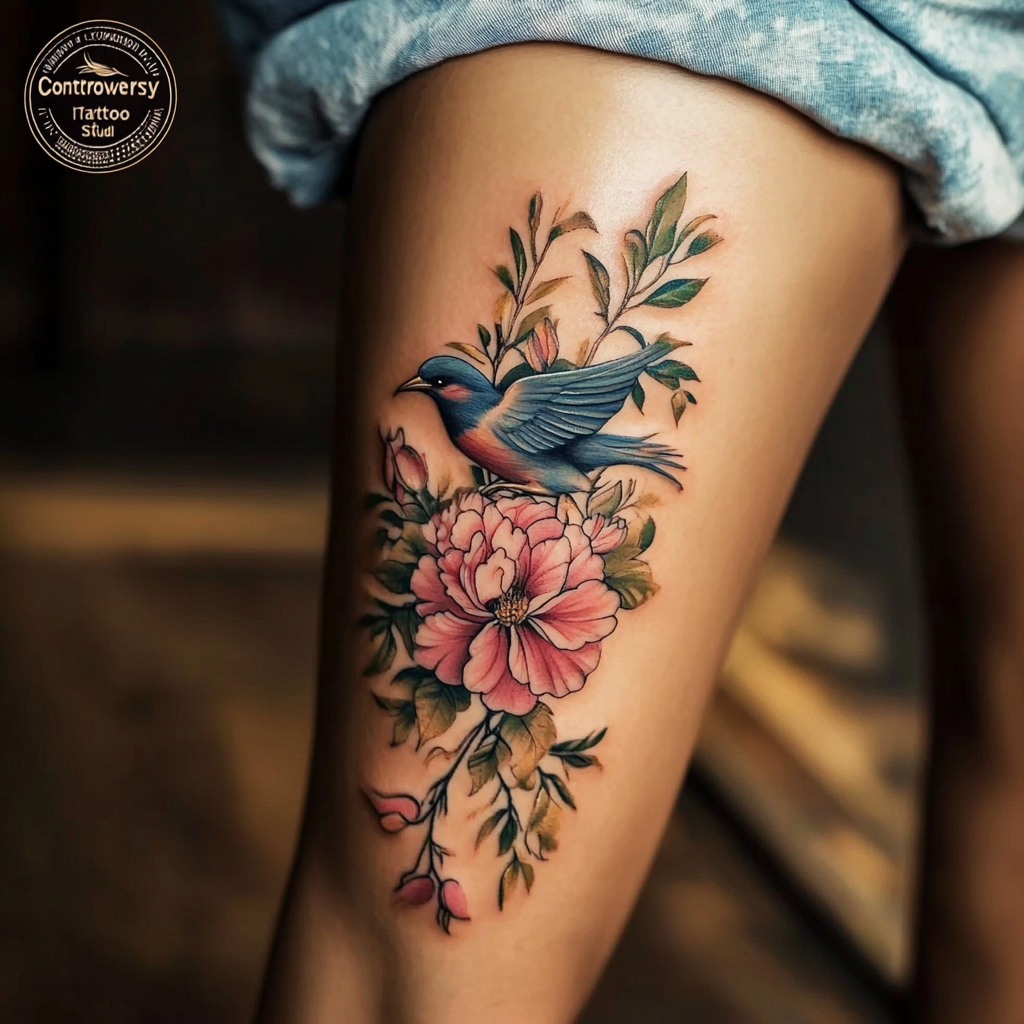
Side leg tattoos offer unique placement options that aren’t always immediately considered. The side of your thigh provides ample space for expansive designs while being relatively easy to conceal when desired. This location works particularly well for flowing, vertical imagery like floral vines, dragons, or abstract patterns that complement your body’s natural lines.
The side of your lower leg presents more challenges due to the natural shape of the calf muscles, but skilled artists can create stunning pieces that enhance these contours. Side leg placements allow you to showcase your tattoo selectively, making them perfect for those who want the option to display their art in casual settings while keeping it professional elsewhere. These designs can stand alone or serve as connecting elements for more extensive tattoo work spanning multiple leg areas.
Ankle and Foot Extensions
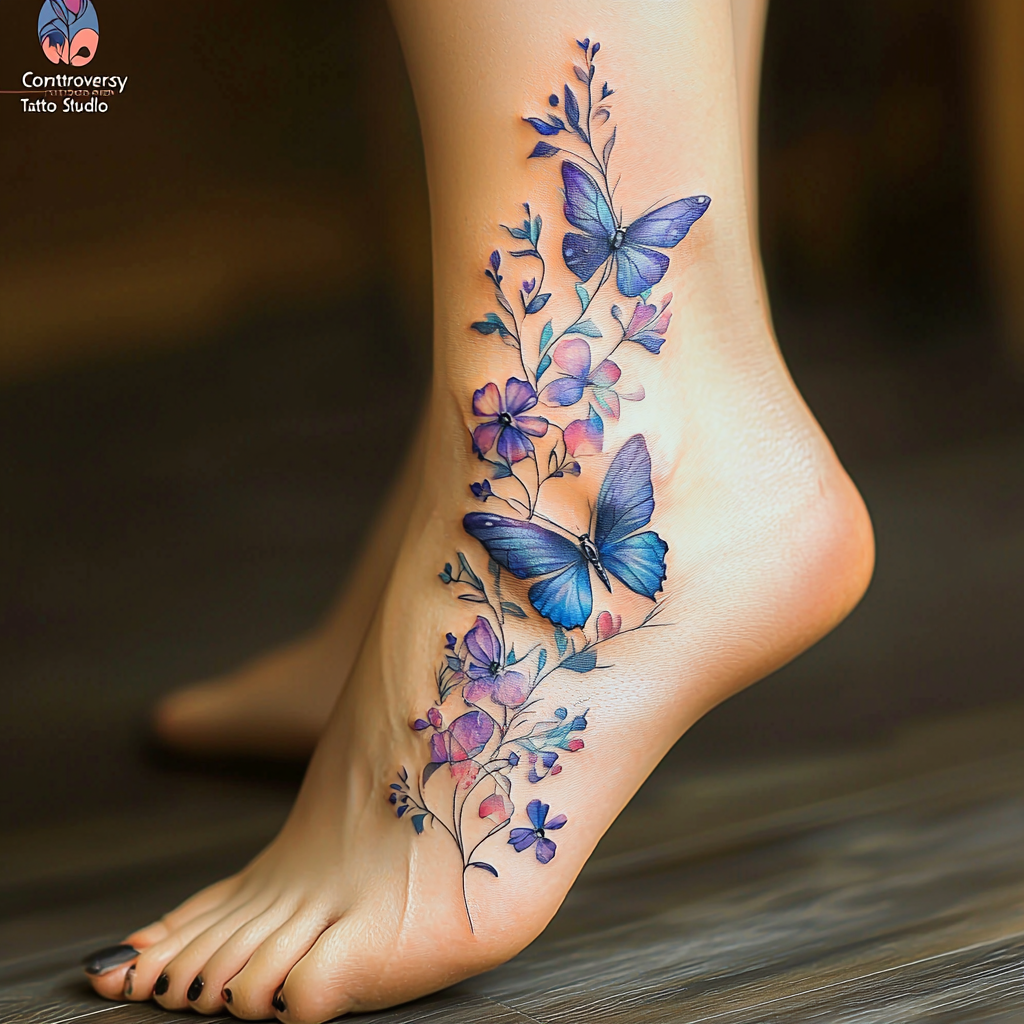
Ankle tattoos offer versatility as they can be prominently displayed or completely hidden depending on your footwear choices. When planning ankle designs, consider placing them high enough above the ankle bone to allow coverage by pants if desired. This placement works beautifully for smaller, delicate designs like minimalist symbols, small floral elements, or meaningful text.
For a more dramatic statement, consider extending your leg tattoo down to incorporate the foot. These extensions create a cohesive flow from leg to foot, though it’s important to note that foot tattoos typically require more frequent touch-ups due to natural skin exfoliation in this area. When planning ankle and foot tattoos, consider how they’ll interact with different shoe styles and be prepared for some additional tenderness during the healing process, as these areas can be sensitive during tattooing and may experience more friction from footwear afterward.
Popular Thematic Leg Tattoo Ideas
Nature-Inspired Designs
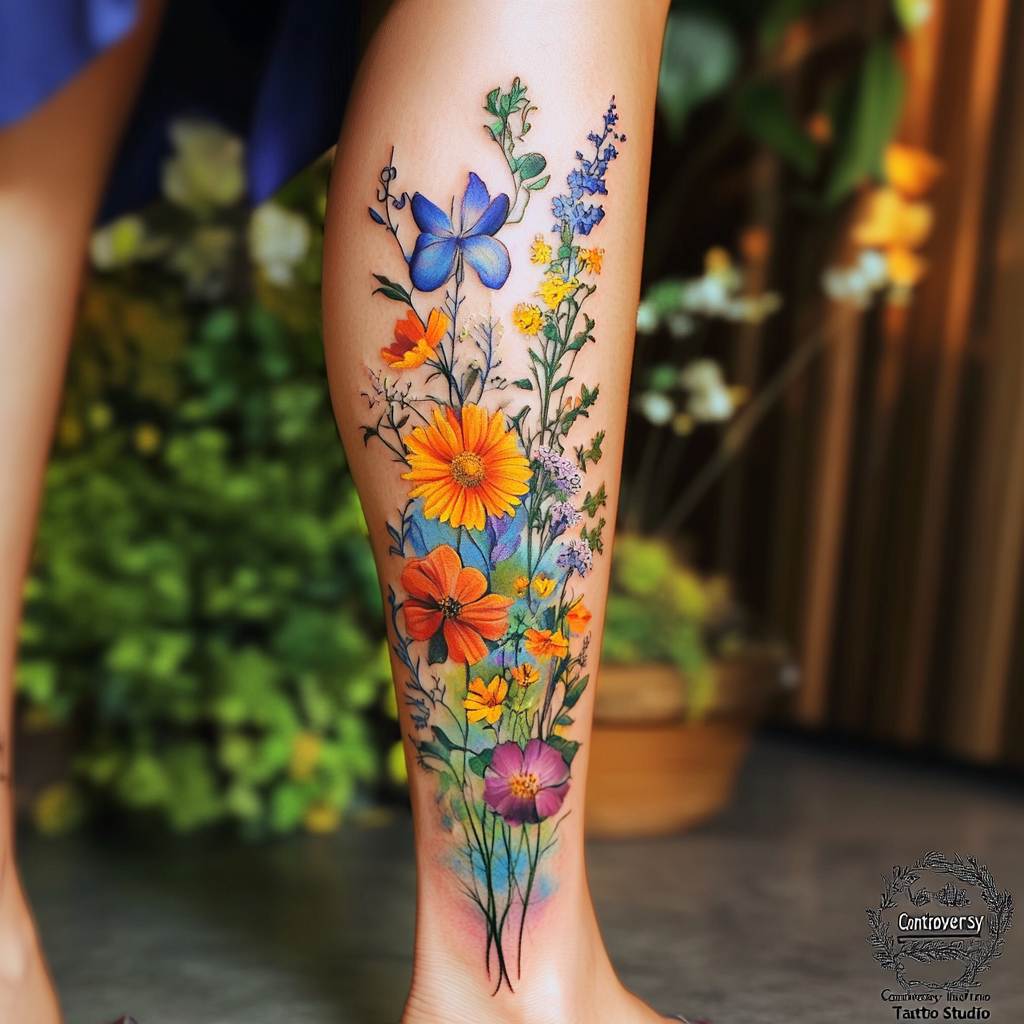
Nature-inspired designs have become one of the most sought-after leg tattoo ideas, offering endless possibilities for stunning artwork. Botanical elements create visually striking tattoos that beautifully complement the natural contours of your legs.
Intricate floral designs that wrap around your calf create an elegant, feminine look. From delicate roses to bold sunflowers, flower tattoos can symbolize growth, beauty, and resilience. For a more subtle approach, consider minimalist plant silhouettes adorning your ankle—simple line drawings of leaves or branches can be both meaningful and stylish.
Forest and tree-themed leg tattoos offer depth and symbolism. A detailed forest scene spanning your thigh provides ample canvas for artistic expression, while a single tree with sprawling roots can represent stability and personal growth. Watercolor techniques can elevate these nature motifs, adding vibrant splashes of color that mimic the unpredictable beauty of the natural world.
Ocean-inspired tattoos also work beautifully on legs. Wave patterns encircling your calf or ankle create a sense of fluid movement, while detailed underwater scenes featuring coral reefs or marine life can transform your leg into a living aquarium.
Animal and Wildlife Tattoos

Animal tattoos on legs allow you to showcase your connection to wildlife while taking advantage of the leg’s contours. The thigh provides an ideal canvas for larger, more detailed animal portraits that can truly capture the essence and power of your chosen creature.
Lion leg tattoos symbolize strength and courage, making them perfect for those wanting to display their inner power. These majestic designs can be enhanced by placing the lion within realistic jungle foliage for a more dynamic scene. Similarly, wolf tattoos represent loyalty and independence, with the elongated shape of a wolf’s face fitting naturally on the calf.
For those preferring more delicate designs, butterfly tattoos on the ankle or calf symbolize transformation and hope. You can opt for a small, single butterfly or create an elaborate design combining multiple butterflies with colorful flowers. Bird tattoos, particularly swallows or eagles, work well as matching designs on the backs of legs, representing freedom and perspective.
Pet memorial tattoos have also gained popularity. Whether it’s a realistic portrait of your beloved companion or a stylized paw print, these tattoos offer a permanent tribute to the special bond you shared.
Mythological and Fantasy Concepts
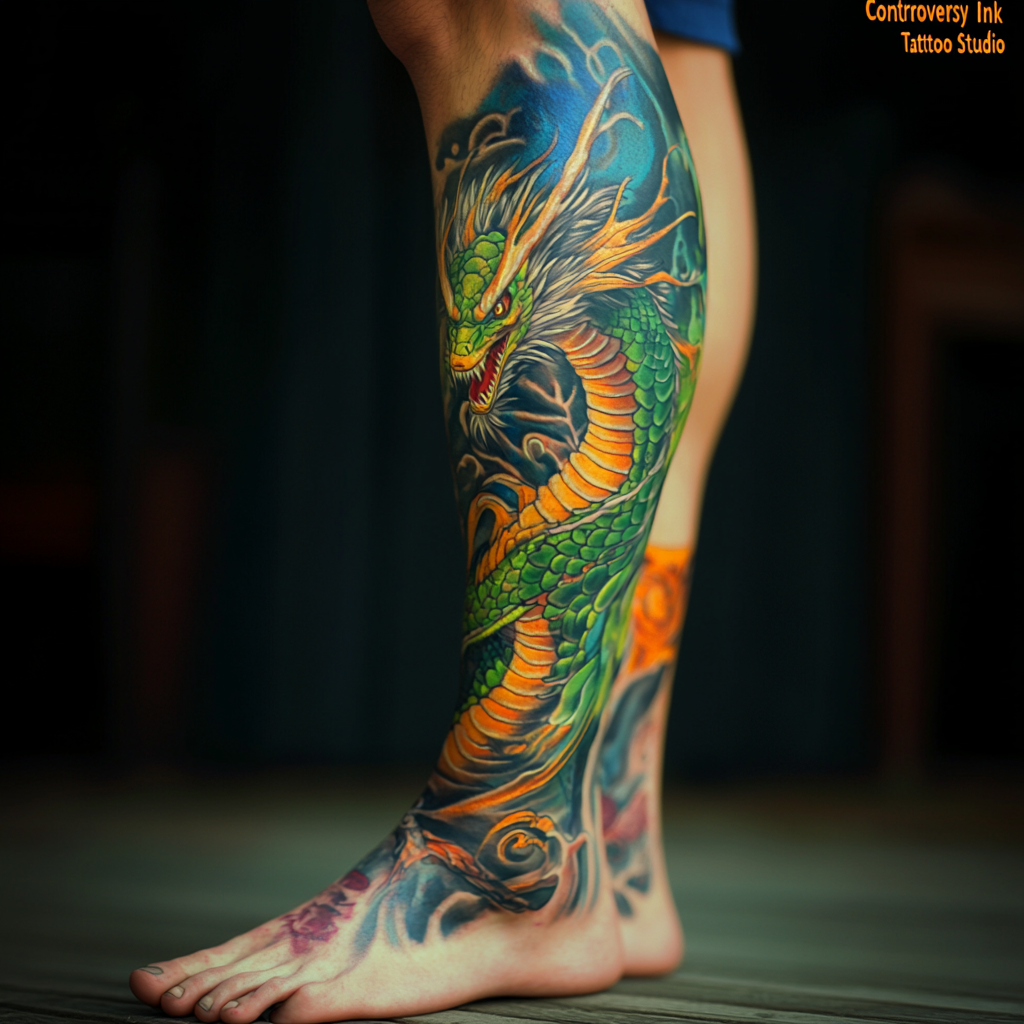
Mythological and fantasy-themed leg tattoos allow for extraordinary creative expression and storytelling. Greek mythology provides rich inspiration, with epic scenes featuring gods, goddesses, and mythical creatures that can span an entire leg sleeve.
Dragon leg tattoos are particularly striking, with the creature’s serpentine form naturally wrapping around the calf or extending along the thigh. These designs symbolize power, wisdom, and protection across many cultures. Phoenix tattoos, representing rebirth and resilience, create spectacular leg pieces with their fiery colors and dramatic wingspan.
Mermaid designs work exceptionally well as leg tattoos, with the tail flowing down the calf or wrapping around the leg. Similarly, fairy tattoos with delicate wings and ethereal elements add a touch of magic and whimsy to your leg art.
For those drawn to darker themes, gothic-inspired designs featuring elements like skulls, ravens, or mystic symbols can be powerful statements. These can be combined with clock faces or hourglasses to represent the passage of time and mortality, creating a thought-provoking leg tattoo.
Cultural and Tribal Patterns
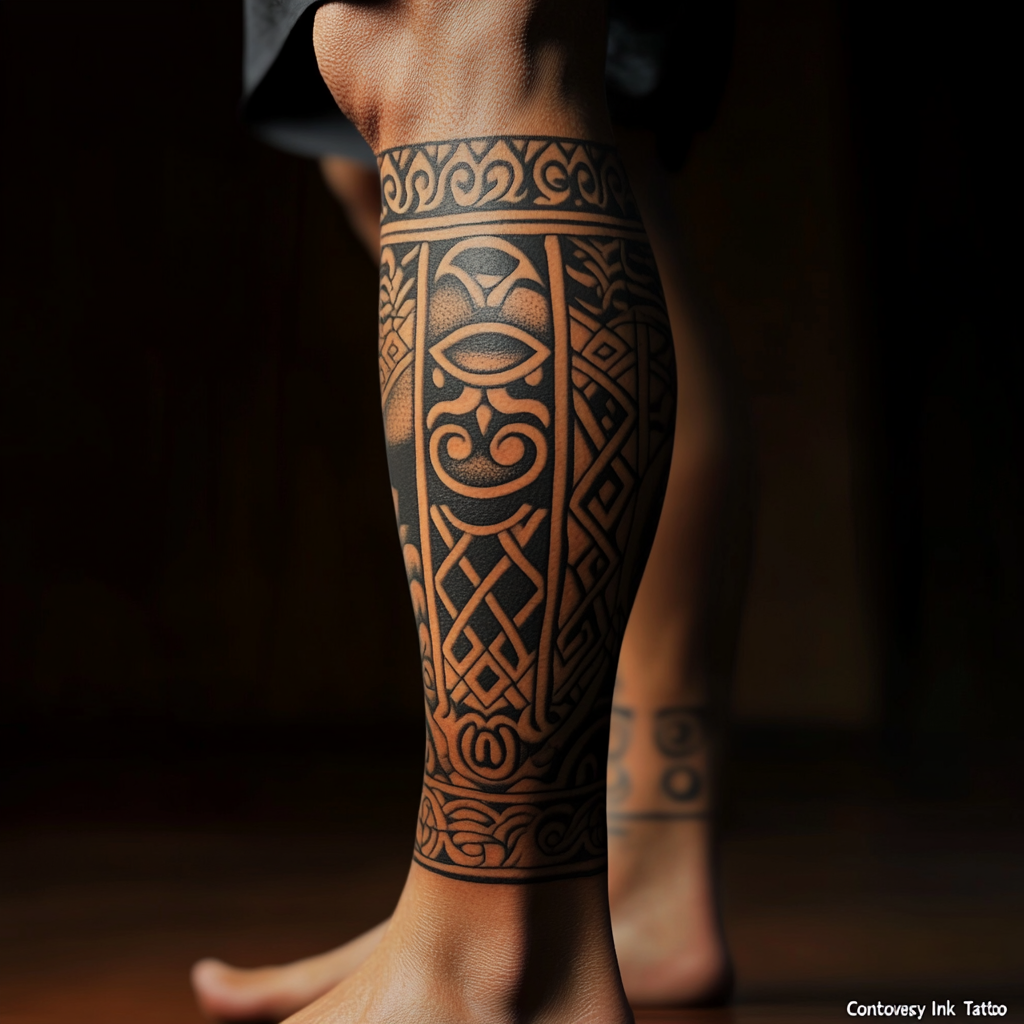
Tribal leg tattoos offer bold, striking designs rich with cultural significance and history. These patterns create powerful visual impact while honoring traditional art forms and personal heritage.
Polynesian tribal designs feature intricate geometric patterns that flow beautifully around the contours of your leg. These tattoos often symbolize strength, family connections, and protection, making them meaningful as well as visually striking. Similarly, Māori-inspired patterns with their distinctive spiral forms create dynamic leg tattoos that represent personal growth and new beginnings.
Celtic tattoos showcase elaborate knots and interwoven patterns symbolizing interconnectedness and eternity. The Celtic cross is particularly popular for leg tattoos, representing faith and heritage. These designs work well as knee tattoos or can be expanded into larger pieces that flow down the calf.
Native American-inspired motifs offer rich symbolism, from dreamcatchers to feathers and animal spirits. These elements can be combined to create a meaningful narrative that wraps around your leg. For contemporary interpretations, modern tribal designs infuse traditional patterns with geometric elements and clean lines, breathing new life into this classic tattoo style.
Traditional mandala tattoos, with their circular, symmetrical patterns, are perfect for the upper thigh or knee area. These intricate designs represent harmony, balance, and the universe, creating a meditative focal point that draws the eye and complements the leg’s natural shape.
Styling Your Leg Tattoo
Full Leg Sleeves
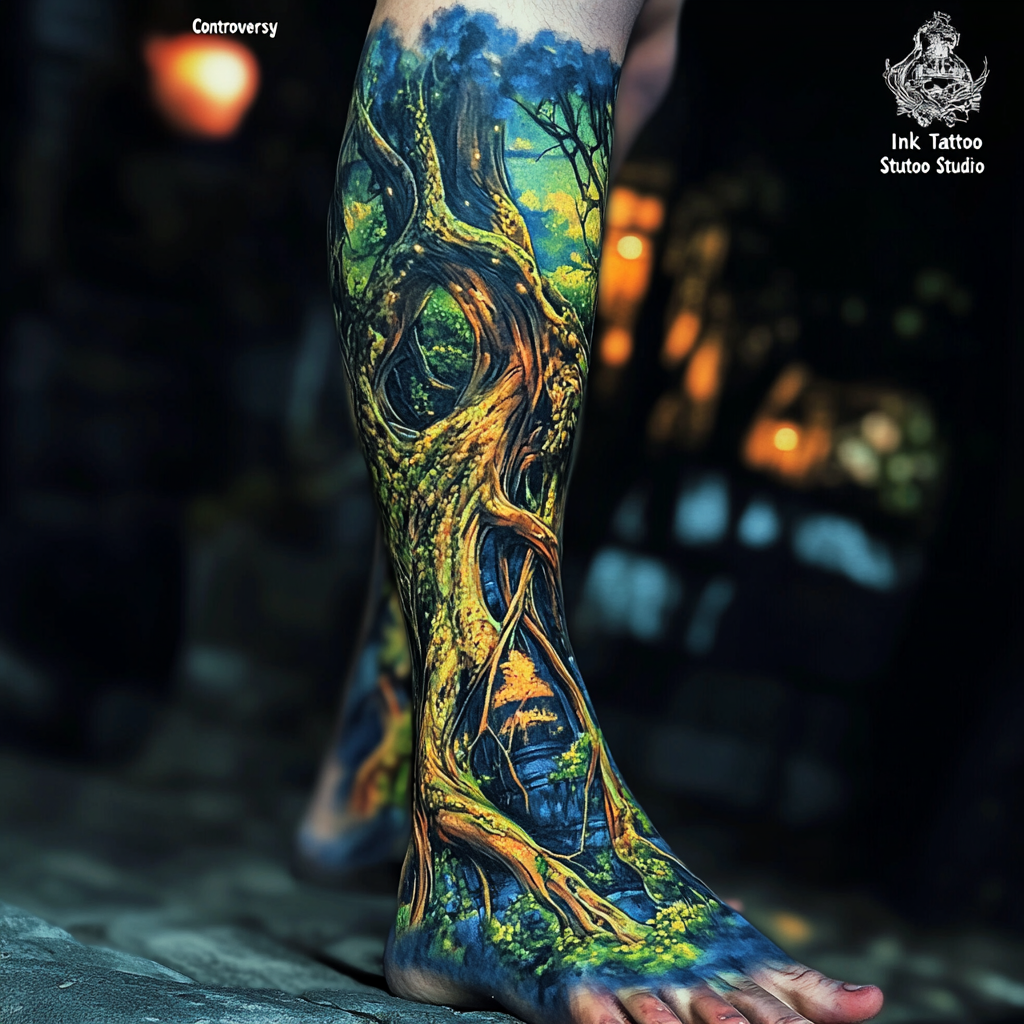
Full leg sleeves are a bold, dramatic choice that covers your entire leg from ankle to thigh. These comprehensive designs allow for intricate storytelling through art, making a powerful statement. When planning a full leg sleeve, consider developing a cohesive theme that flows naturally with your leg’s contours. Mythological scenes, nature landscapes, or biomechanical wonders work exceptionally well in this format.
For women seeking an ambitious leg tattoo project, consider how different elements will transition across the various parts of your leg. Japanese-inspired designs offer beautiful flow, while American traditional styles can create a patchwork effect that’s equally striking. Remember that full leg sleeves require multiple sessions, substantial investment, and expertise in composition and color distribution.
Half Leg Sleeves
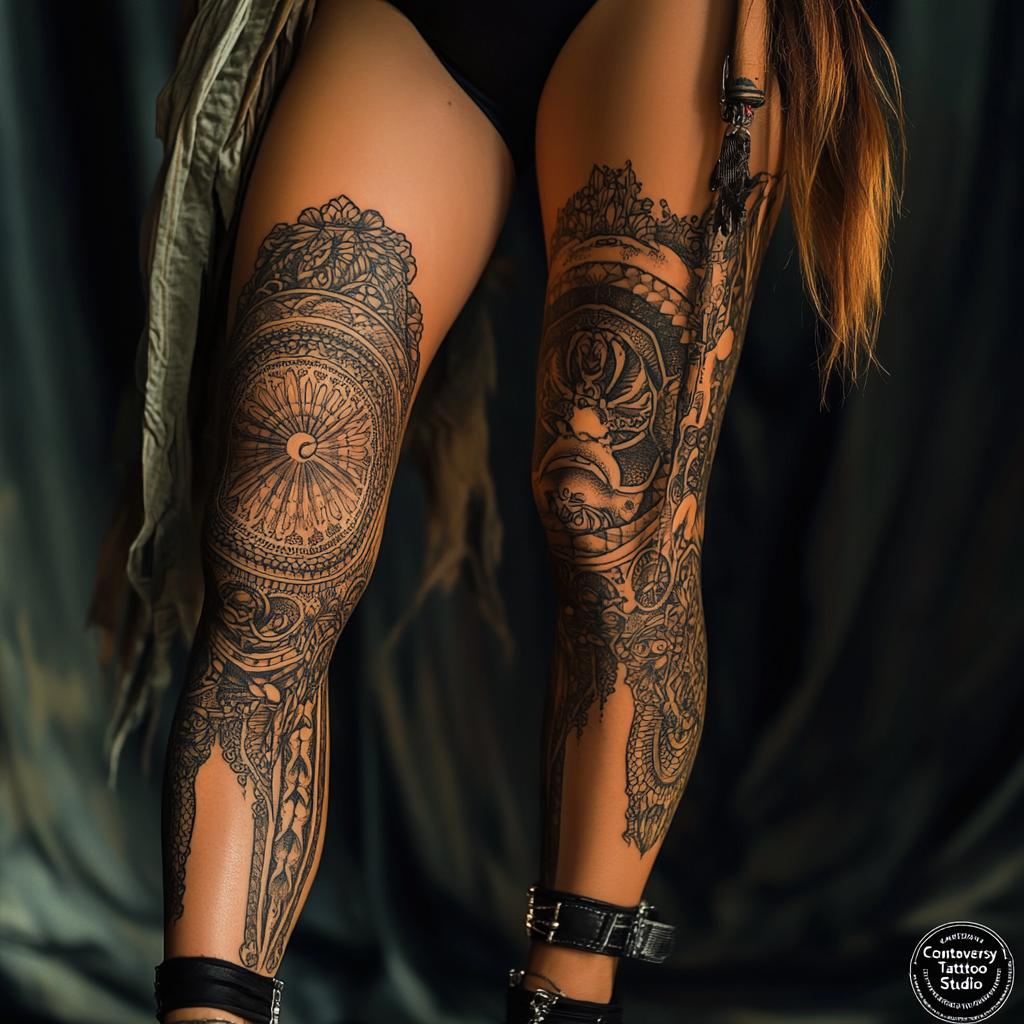
Half leg sleeves offer the perfect compromise between a statement piece and a more moderate commitment. Covering either your upper or lower leg, these designs provide ample creative space while requiring less time under the needle. Popular half sleeve options include mandala patterns on the upper thigh for women, creating an elegant, symmetrical appearance.
For lower leg half sleeves, tribal patterns like Polynesian designs work wonderfully as they naturally wrap around the calf muscle. Celtic knots and geometric patterns are also striking choices that complement the leg’s natural shape. When planning your half sleeve, consider how the design will look both when standing and when your leg is bent, ensuring the artwork remains aesthetically pleasing in various positions.
Wrap-Around Designs
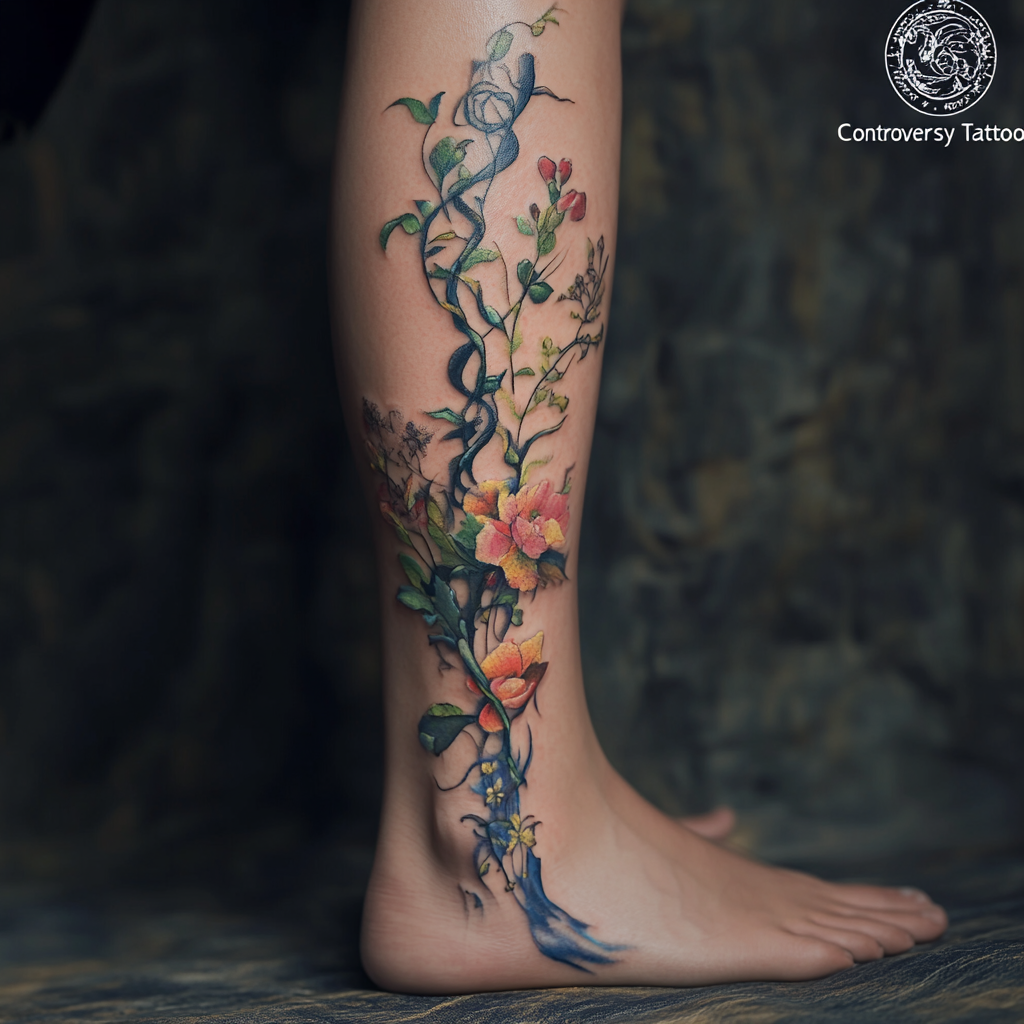
Wrap-around leg tattoos create a dynamic visual effect by encircling your leg, using its cylindrical shape to enhance the design. These tattoos work particularly well with flowing elements like floral vines, tribal bands, or continuous geometric patterns. The wrapping effect creates movement and dimension that flat designs simply can’t achieve.
For a more subtle approach, consider a delicate botanical branch that wraps gently around your ankle or calf. More dramatic options include watercolor splashes that encircle your thigh or detailed snake designs that coil around your leg. The curved nature of wrap-around tattoos complements your leg’s natural contours, creating harmony between your body and the artwork.
Small Accent Pieces
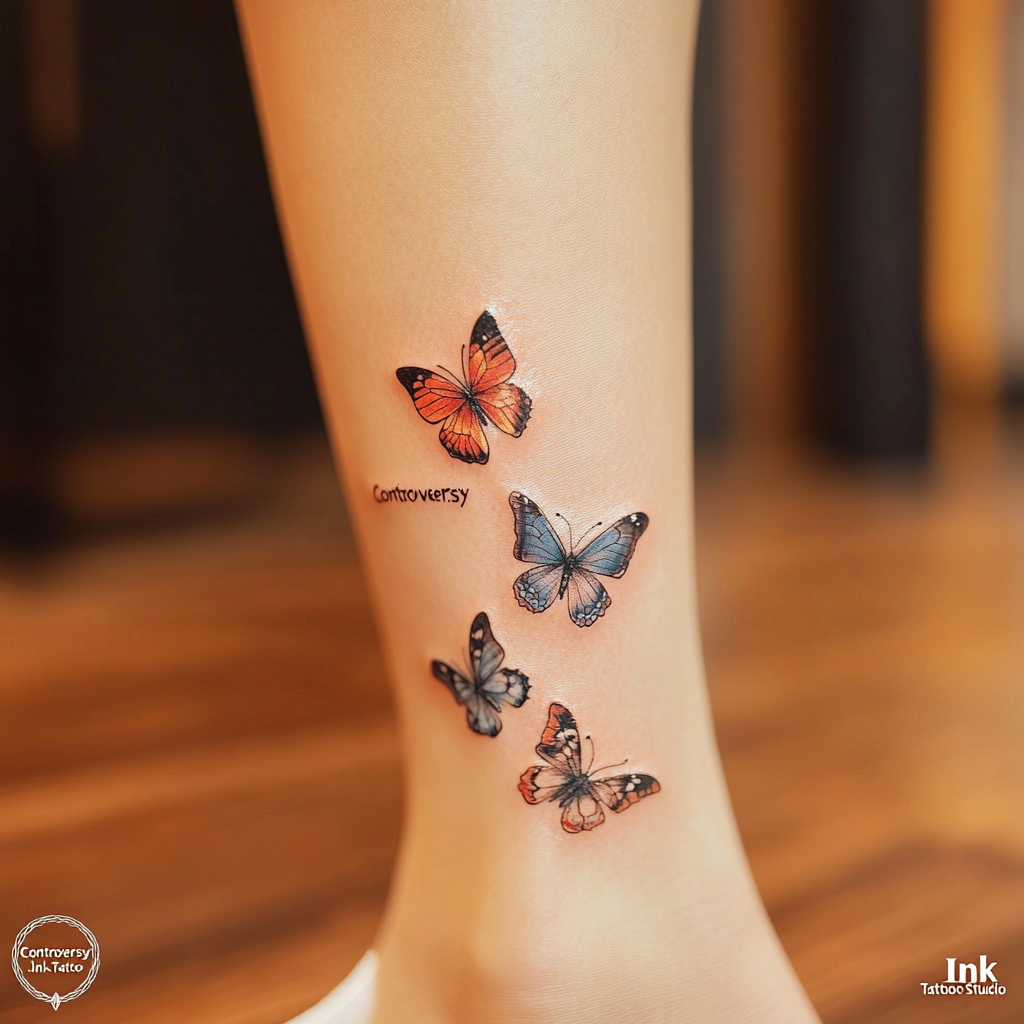
Small accent pieces offer versatility and elegance for those seeking more subtle leg tattoo ideas. A tiny butterfly at the ankle, a delicate star on the side of the calf, or a minimalist line drawing on the outer thigh can make a significant impact without overwhelming your leg. These smaller designs are perfect for first-timers or those who prefer a more discreet artistic expression.
Single-needle and fine-line techniques work beautifully for these smaller pieces, creating intricate details that stand out despite their size. Consider placement carefully—small tattoos on the top of the thigh offer privacy, while ankle placements provide visibility when desired. The beauty of small accent pieces lies in their ability to hold deep personal meaning while remaining easy to conceal when needed.
Specialized Leg Tattoo Techniques
The leg offers a unique canvas for artists to showcase their technical prowess through various specialized tattooing methods. These techniques can transform even simple leg tattoo ideas into extraordinary works of art.
Geometric and Abstract Patterns
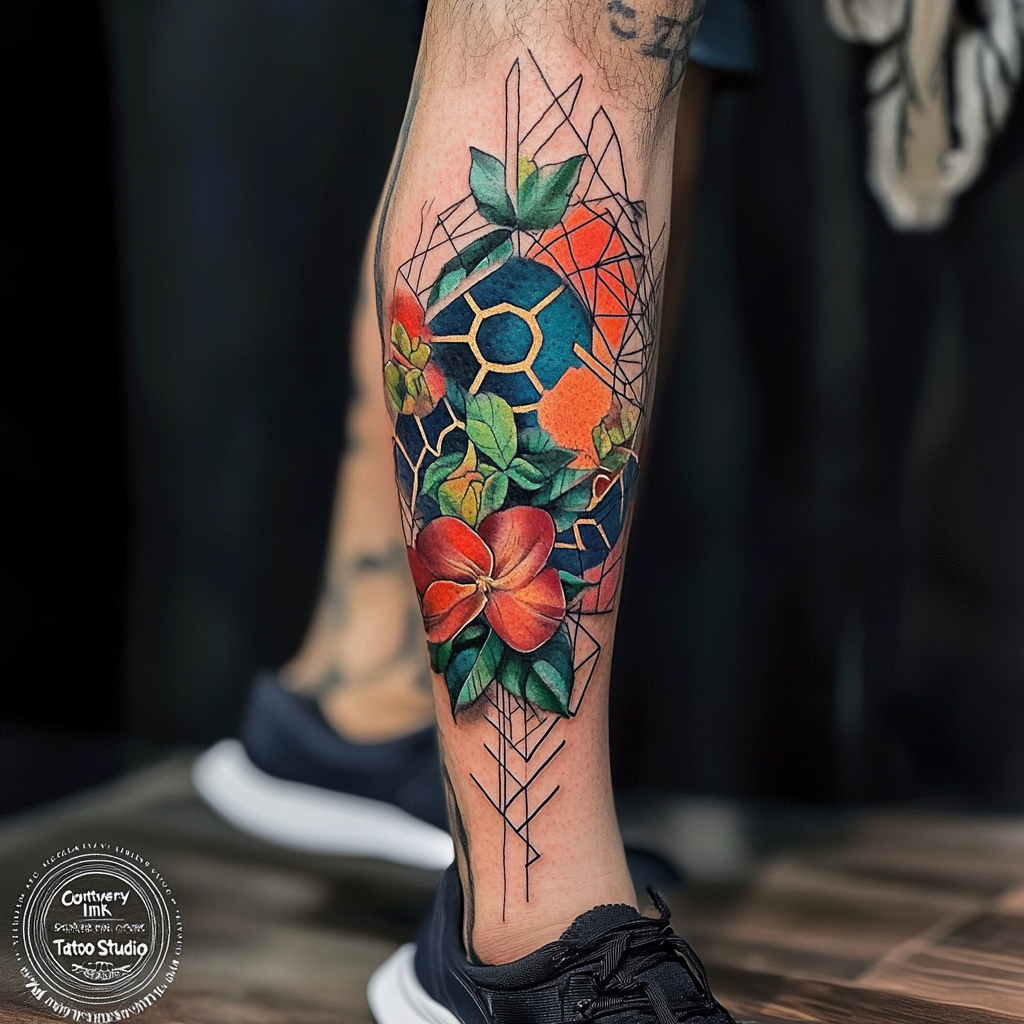
Geometric leg tattoos have gained immense popularity for their clean lines and mathematical precision. These designs feature shapes like triangles, hexagons, and circles arranged in tessellated patterns that flow beautifully with the leg’s contours. You’ll find that geometric patterns work exceptionally well as wrap-around calf designs or along the thigh where the flat surface showcases the precision of the lines.
Abstract patterns take geometric concepts further by breaking conventional rules. They incorporate asymmetrical elements, unexpected color transitions, and non-representational forms that make for truly unique leg tattoos. Consider combining abstract patterns with meaningful symbols for a tattoo that’s both visually striking and personally significant.
Watercolor and Painterly Styles
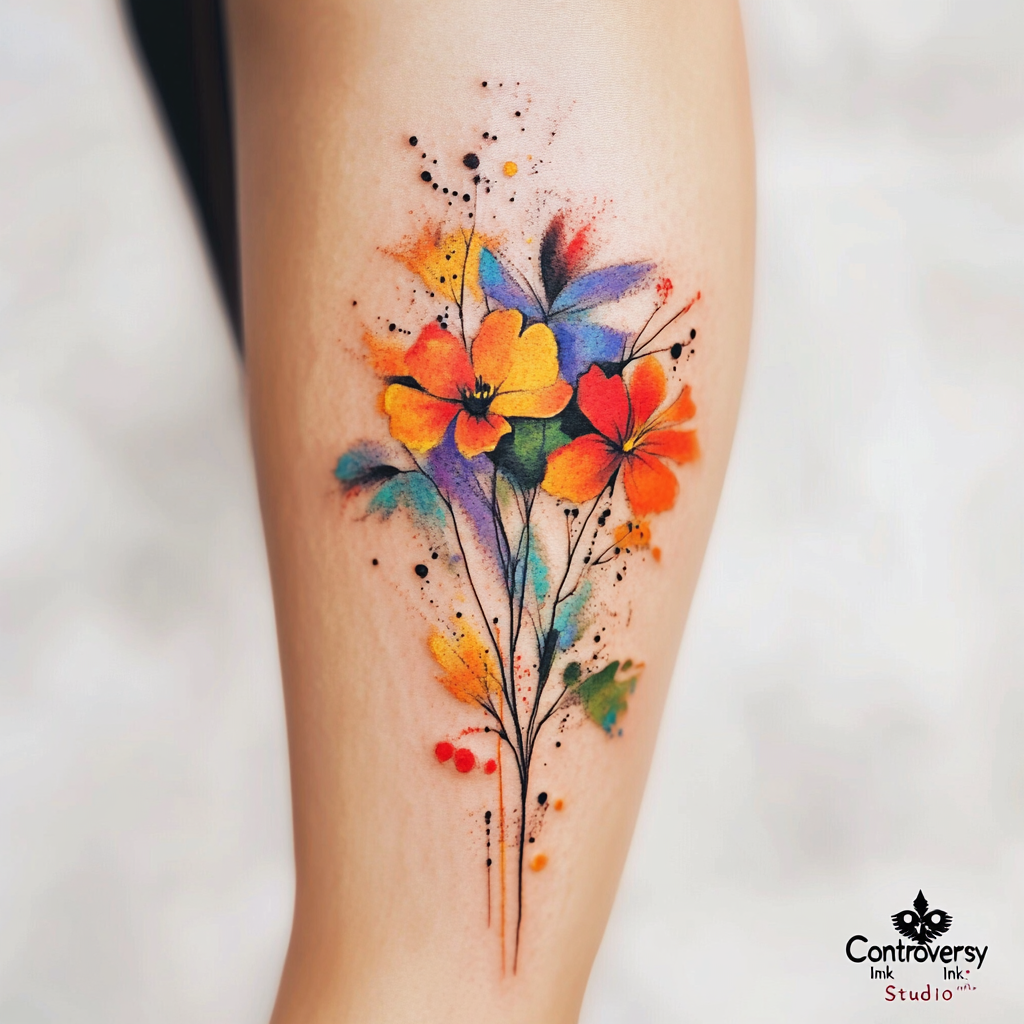
Watercolor tattoos mimic the fluid, ethereal quality of watercolor paintings with their soft edges and vibrant color blending. This technique uses little to no black outlines, instead relying on subtle color shifts and gradual blending to create stunning visual effects. Your leg provides ample space for watercolor designs to breathe and stand out, making it an ideal placement for this style.
The painterly technique brings brush stroke aesthetics to your skin, creating tattoos that look like they’ve been painted directly onto your leg. These designs often incorporate splashes, drips, and artistic texture that add dimension and movement. Floral designs, landscapes, and animal portraits are particularly striking when rendered in watercolor or painterly styles on the leg’s expansive canvas.
Blackwork and Dotwork Options

Blackwork tattoos have experienced a resurgence in popularity, especially for leg designs. This technique uses solid black ink to create bold, striking imagery with strong contrast. On the leg, blackwork designs can range from intricate mandalas on the knee to bold tribal-inspired patterns wrapping around the calf. The technique is particularly effective when combined with negative space patterns that allow your skin to become part of the design.
Dotwork creates intricate images through thousands of tiny dots rather than solid lines. This painstaking technique produces stunning gradient effects and textural elements perfect for detailed leg tattoos. The method works beautifully for mandalas on the calf, spiritual symbols on the ankle, or even full-leg sleeve designs with elaborate shading. Though dotwork requires more time and patience, the results offer unparalleled detail and dimension.
Realistic and 3D Illusions
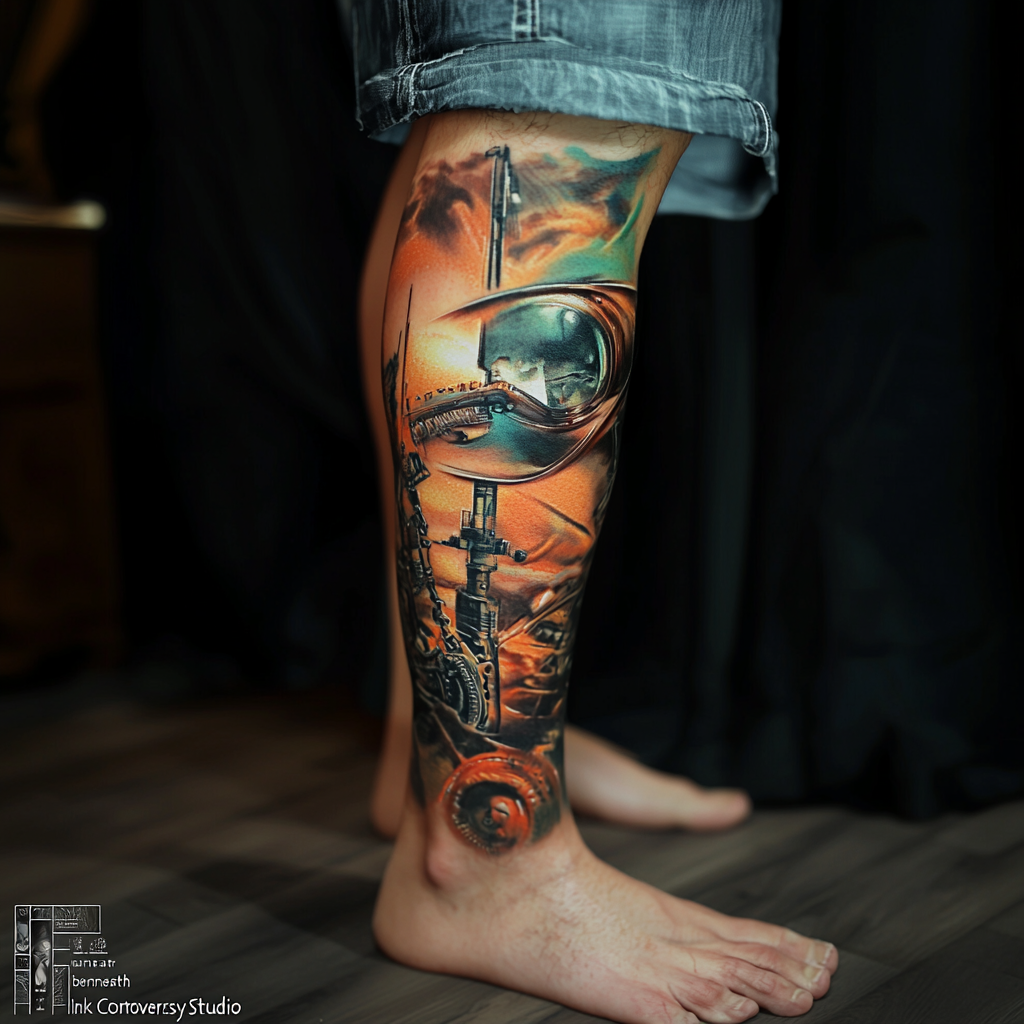
Realistic tattoos bring photographs to life on your skin through meticulous attention to detail, shading, and proportion. The leg’s flat, expansive surface makes it ideal for portrait work, nature scenes, or wildlife imagery. These tattoos require highly skilled artists who can capture subtle nuances of light and texture, resulting in images that appear to jump off your skin.
3D illusion tattoos create mind-bending visual effects that make tattoos appear to float above the skin or reveal what’s beneath it. Popular leg illusion tattoos include mechanical components “beneath” the skin, ripped skin effects revealing different imagery, or objects that appear to be sitting on the leg’s surface. These designs take advantage of the leg’s natural contours to enhance the three-dimensional effect, creating conversation-starting pieces that challenge perception.
Practical Considerations Before Getting Inked
Before committing to leg tattoo ideas, it’s important to understand the practical aspects that will affect your experience and results. These considerations will help you make informed decisions about your new ink.
Pain Levels by Leg Location
Pain tolerance varies significantly across different leg areas. The upper outer thigh is one of the least painful places to get tattooed due to its thick padding of fat and fewer nerve endings. Similarly, the calf muscle provides good cushioning, making it relatively comfortable for tattooing.
Bony areas tell a different story. The shin, ankle, knee, and behind the knee can be considerably more painful. When the tattoo needle hits close to bone, the reverberations cause increased discomfort. The skin behind the knee is also thinner and more sensitive, amplifying pain during the process.
Your individual pain threshold plays a crucial role in your experience. What feels intensely painful to one person might be merely uncomfortable to another. Additionally, longer tattoo sessions can increase discomfort as your skin becomes more irritated over time.
The tattooing technique also affects pain levels. Shading often feels different from line work, and detailed designs typically require more needle time in one area. Discussing pain management strategies with your artist beforehand can help make your leg tattoo experience more comfortable.
Healing Process for Leg Tattoos
Proper aftercare is essential for leg tattoos to heal correctly and maintain their vibrancy. Follow these critical steps to ensure optimal healing:
- Keep the wrap on until instructed by your artist to remove it (typically the next day)
- Clean the tattoo with antibacterial, fragrance-free soap several times daily
- Apply the recommended moisturizing cream to keep the area well-hydrated
- Repeat the cleaning and moisturizing process after each shower for the first few days
- Use only unscented body lotion once the initial healing begins
- Apply lotion 2-3 times daily until peeling stops
- Use sunblock consistently to protect your healing tattoo
- Check in with your tattoo artist after about 3 months
- Contact your artist immediately if you notice anything unusual during healing
Knee tattoos require special consideration during healing. Plan for approximately a week of reduced movement to avoid excessive joint flexing, which can impede the healing process and affect the final appearance of your design.
During summer months, be especially vigilant about applying sunscreen to your leg tattoos, particularly if they’re still healing or contain vibrant colors that are prone to fading with UV exposure.
Cost Expectations and Time Investment
The cost of leg tattoos varies widely based on several factors. Size, detail, and complexity significantly impact the price—larger, more intricate designs naturally cost more than simple, smaller pieces. Color usage also affects pricing, with full-color leg tattoos typically commanding higher rates than black and gray work.
Artist expertise plays a major role in cost determination. Renowned artists with high demand or those specializing in particular styles often charge premium rates. While this might seem expensive, investing in a reputable artist ensures both quality and safety.
Location also influences pricing. Studios in urban areas or cities with higher costs of living generally charge more than those in smaller towns. For an accurate estimate, consult directly with your chosen artist, who can provide pricing based on your specific design requirements.
As for time investment, small, simple designs might take as little as an hour, while detailed pieces can require multiple sessions spanning several hours each. Full leg sleeves represent one of the biggest tattoo projects you can undertake, often requiring numerous appointments spread over weeks or months.
Color work extends the time frame, as each color requires the artist to switch inks and techniques. The tattoo style also impacts duration—precise work like dot work or geometric designs typically takes longer than more freehand styles.
Maintenance and Longevity Factors
The longevity of your leg tattoo depends on several key factors. Sun exposure significantly impacts fading—leg tattoos are frequently exposed to sunlight, especially during warmer months. Consistent application of high-SPF sunscreen helps maintain vibrancy and reduces the need for touch-ups.
Friction from clothing affects leg tattoos differently depending on placement. Thigh tattoos may experience rubbing from tight pants, while ankle tattoos can be irritated by shoes and socks. Consider your regular clothing habits when choosing placement.
The tattoo’s design complexity and color choices influence how well it ages. Fine lines tend to blur faster than bold ones, and certain colors like pastels and whites may fade quicker than darker inks. Quality work from an experienced artist typically lasts longer with less deterioration.
Touch-ups are occasionally necessary to maintain your leg tattoo’s appearance. Most tattoos benefit from a refresh every few years, though this varies based on individual factors. Tattoos created by experienced artists using quality inks often maintain their vibrancy longer, potentially extending the time between touch-ups.
Proper ongoing care extends your tattoo’s life. Regular moisturizing helps preserve skin elasticity and tattoo clarity, while protecting your ink from prolonged sun exposure prevents premature fading. Your commitment to these maintenance practices directly impacts how well your leg tattoo stands the test of time.
Choosing the Perfect Leg Tattoo Design
Your leg tattoo journey is a deeply personal adventure that combines artistry with self-expression. Whether you’re drawn to delicate florals wrapping around your ankle or bold geometric patterns covering your thigh the possibilities are truly endless.
Remember that the perfect design balances your aesthetic preferences with practical considerations like pain tolerance and aftercare commitment. Take time to research artists who specialize in your desired style and don’t rush the decision-making process.
Your leg tattoo will become a permanent part of your story so choose something that resonates with your authentic self. With proper care and thoughtful planning your leg art will continue to inspire and delight you for years to come.
Frequently Asked Questions
What are the most popular leg tattoo designs?
The most popular leg tattoo designs include floral patterns, tribal motifs, watercolor splashes, and minimalist line work. Nature-inspired designs featuring forests or ocean scenes are particularly trendy, as they complement the leg’s natural contours. Animal portraits work well on thighs, while butterflies suit ankles perfectly. Mythological themes like dragons and cultural patterns such as Polynesian or Celtic designs are also highly sought after for their rich symbolism and visual impact.
Which part of the leg is best for a tattoo?
The best placement depends on your design and preferences. The upper leg and thigh offer a large canvas for detailed work with added discretion. Calves are ideal for bold statements and visible designs when wearing shorts. The side leg works well for flowing designs that follow your natural contours. Ankles provide versatility for smaller pieces. Consider visibility, pain sensitivity, and how the design complements your leg’s shape when choosing placement.
Are leg tattoos more painful than other areas?
Pain levels vary by location on the leg. The upper outer thigh and calf muscle are generally less painful due to more padding and fewer nerve endings. Bony areas like the shin, knee, and ankle tend to be more uncomfortable during tattooing. Everyone’s pain tolerance differs, but most people find leg tattoos moderate in terms of discomfort compared to ribs or spine tattoos.
How much does a leg tattoo typically cost?
Leg tattoo costs vary widely based on size, detail, color, and artist expertise. Small, simple designs might start around $100-200, while half-leg sleeves can range from $500-1,500. Full leg sleeves with intricate detail work could cost $2,000-5,000+ and require multiple sessions. Always consult with your chosen artist for an accurate quote based on your specific design and placement.
How long does a leg tattoo take to heal?
Most leg tattoos take 2-3 weeks for the surface layer to heal and 4-6 weeks for complete healing. The healing process may vary depending on placement—knee tattoos typically require more time due to movement. Follow your artist’s aftercare instructions carefully, keeping the area clean and moisturized. Avoid swimming, excessive sun exposure, and tight clothing that rubs against the tattoo during healing.
What’s the difference between full and half leg sleeves?
Full leg sleeves cover the entire leg from ankle to hip, creating a comprehensive canvas for elaborate storytelling through connected themes. They require significant time and financial investment. Half leg sleeves typically cover either the upper or lower portion of the leg, offering a balance between making a statement and commitment level. Both styles allow for intricate designs but differ in coverage and overall impact.
How do I maintain my leg tattoo’s appearance long-term?
Protect your leg tattoo from sun exposure by applying SPF 30+ sunscreen when outdoors. Moisturize regularly to keep skin hydrated and prevent fading. Avoid excessive friction from tight clothing when possible. Touch-ups every few years may be necessary to maintain vibrancy, especially for colorful designs. Regular skincare helps preserve detail and color saturation throughout the tattoo’s lifetime.
Which leg tattoo techniques create the most visual impact?
Geometric and blackwork techniques offer bold, striking visuals with clean lines and strong contrast. Watercolor styles create vibrant, fluid effects that stand out with their painterly appearance. Realistic and 3D illusion tattoos generate significant visual impact by creating lifelike images or mind-bending effects that challenge perception. The technique that creates the most impact ultimately depends on your personal aesthetic preferences.
Can I get a leg tattoo if I’m an athlete or very active?
Yes, active individuals can get leg tattoos, but timing and placement considerations are important. Schedule your tattoo during an off-season or lower activity period to allow proper healing. Discuss with your artist about placement that minimizes friction from equipment or movement. Be prepared to modify your workout routine temporarily during the healing process to prevent excessive sweating and irritation on the fresh tattoo.
Do leg tattoos fade faster than tattoos on other body parts?
Leg tattoos may fade somewhat faster than those on less exposed areas due to regular sun exposure when wearing shorts and friction from clothing. However, proper care significantly minimizes fading. Lower leg tattoos, especially on ankles and feet, can experience more wear from shoes and daily activities. Regular moisturizing and sun protection are essential for maintaining vibrancy regardless of placement.

